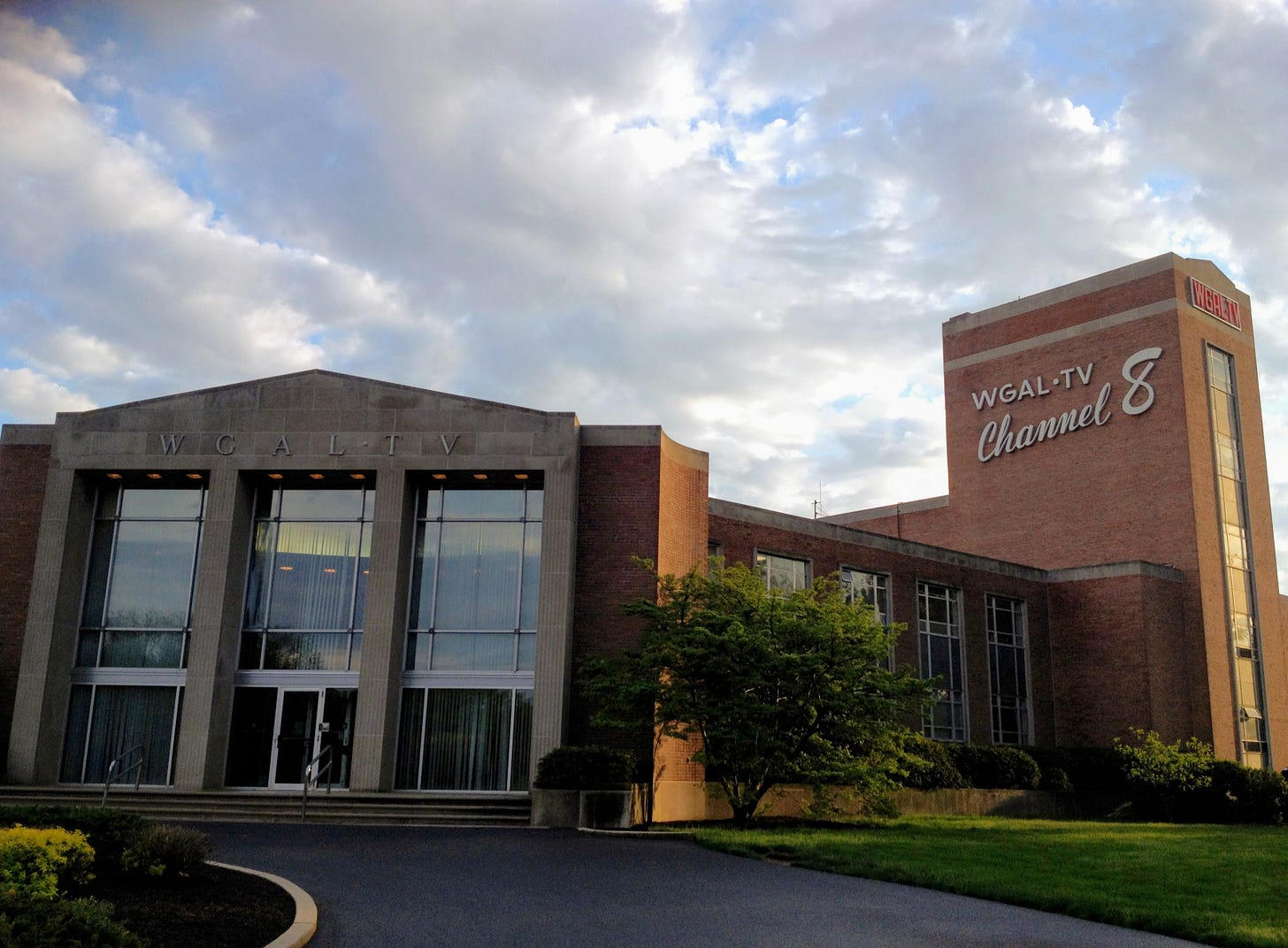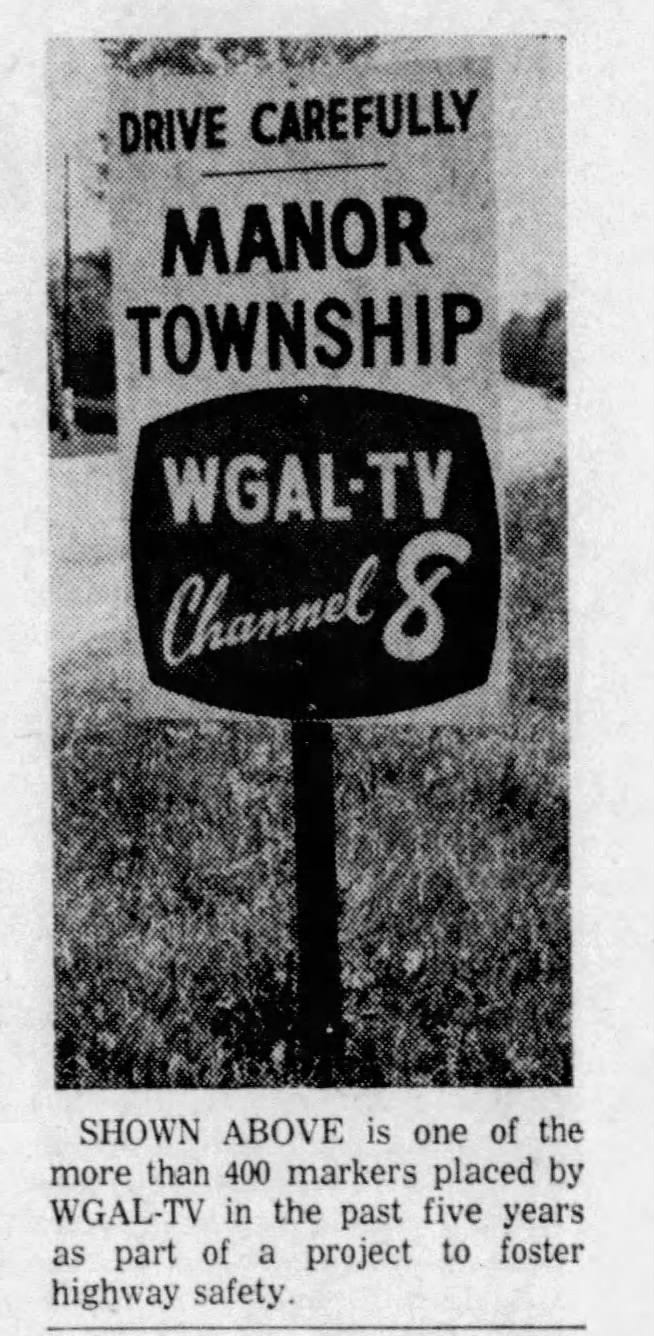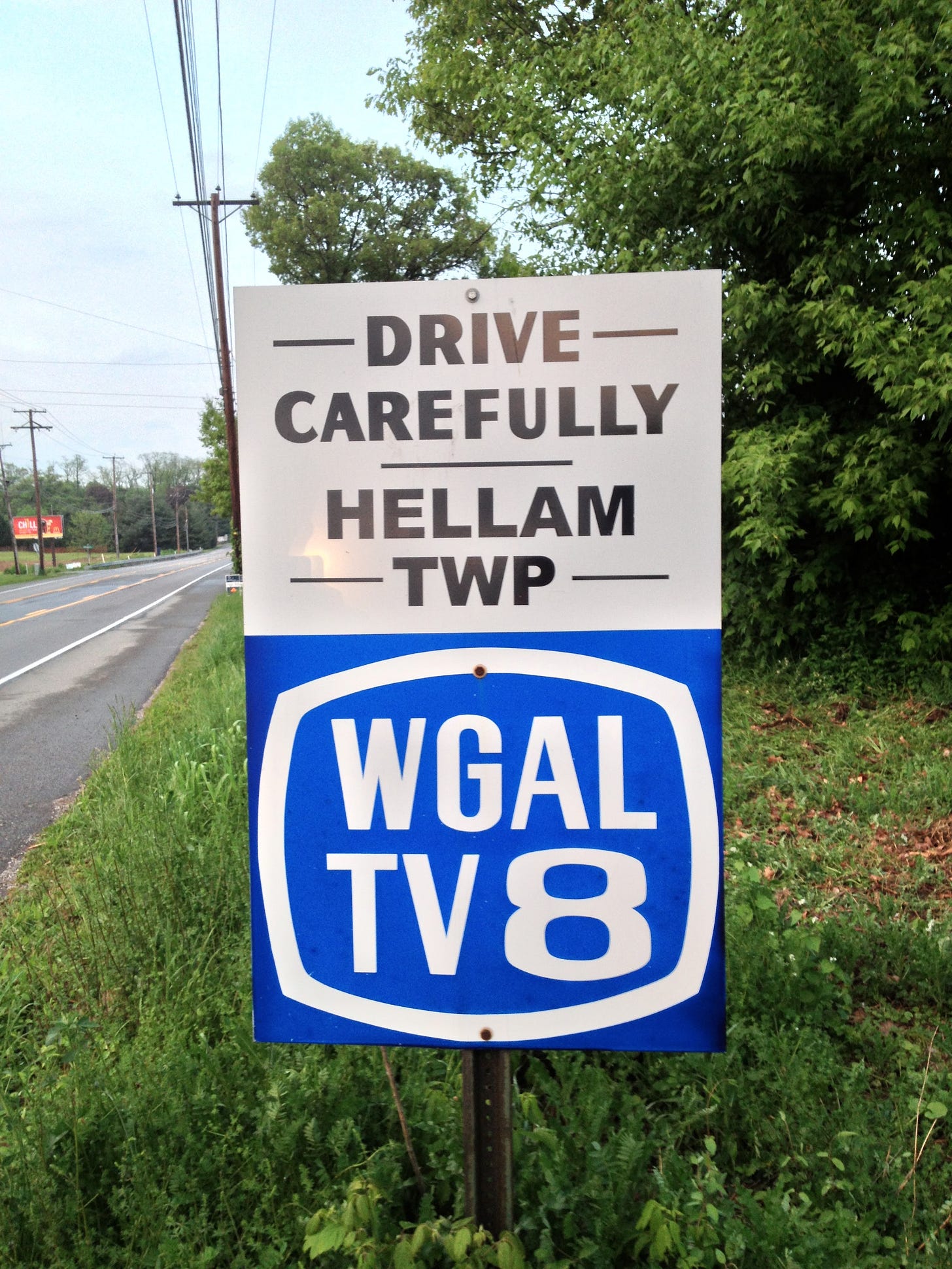Gemini Giant saved, to stay on Route 66; classic '60s McDonald's sign restored; TV station's 67 years of roadside public service | Retrologist Roundup
Plus: A Pizza Hut Classic in Florida; Pennsylvania on my mind; and a tribute to the "Waving Man of Berkeley" -- have a good day!
This is big news in more ways than one: the Gemini Giant has been saved!
On Wednesday, the 28-foot-tall icon of Route 66 was sold at auction for $275,000. And no, it wasn’t some rich guy who bought it. This story, which began under such grim circumstances, gets so much better.
The Joliet Area Historical Museum purchased the Muffler Man and donated it to the city of Wilmington, the Gemini Giant’s longtime home. The money came from a state grant.
While the new home of the giant is prepared, the giant will live on the grounds of the American Giants Museum in Atlanta, Illinois. The giant was already picked up and moved to its temporary home.
The Giant’s new forever home has already been chosen.
Wilmington Mayor Ben Deitz issued a statement on Wednesday revealing the Gemini Giant will be moving to the entrance of a park in town, stand next to a Route 66 monument, and most importantly, stay on the Mother Road.
"Earlier this year, the City Council approved plans to re-imagine the entrance to our South Island Park," Deitz explained. "The park not only sits directly along Route 66 but is also adjacent to our historic downtown and along the Kankakee River National Water Trail. Initially, the plans included placement of a Route 66 monument, a walking trail and a new dedicated parking lot.
"With today's news, the city is happy to announce that the Gemini Giant will also be on display right alongside the Route 66 monument. This will ensure the Gemini Giant will remain in a secure location that is fully accessible to residents and travelers alike ... Having the Route 66 monument right alongside the Gemini Giant will be sure to be a must-have photo op. It is the city's hope to have the park, with its new iconic resident, ready to meet visitors in late spring this year."
Read the city’s full press release here.
The Giant's epic rescue follows residents' efforts to crowdsource money to save the statue.
The American Giants Museum has played a key role in the salvation of this and other roadside giants.
“There are times when you get to take part in something noble and exciting. Helping play a small role in the efforts to save the Gemini Giant definitely falls into that category. The American Giants Museum is incredibly pleased the Gemini Giant will stay in Wilmington, where he belongs,” the museum said on Facebook. Check out photos of the move here.
Below is my earlier coverage of the Gemini Giant:
Gemini Giant, astronaut icon of Route 66, is up for auction, likely to leave his longtime orbit
The Gemini Giant is one of Route 66's great attractions. I was not a little starstruck when I visited Wilmington, Illinois, to photograph him in 2013 and the restaurant he’s been promoting since the 1960s, The Launching Pad. According t…
Tornado-ravaged McDonald’s sign is restored
Some good McNews landed in my inbox. A classic McDonald’s sign that was severely damaged in a tornado last year has been restored, Clay Walker informed me. The sign, located at a McDonald’s in Little Rock, Arkansas, is a “Skinny M,” as Debra Jane Seltzer calls this kind. (I often default to calling them the “Big Ms.”) These are a dwindling breed installed between 1963 and 1968, when McDonald’s signage, in an era of pushback over architectural taste, became more subdued — or as subdued as we can call signs with the colors yellow and red.
Here’s a picture of how it looked in June 2023, after the damage. Clay sent along the “after” picture, below, and the sign looks good as new. A noticeable change is the loss of the words “Drive-Thru” and Seltzer says this may have been the last Skinny M that featured those words on it. The building has been McBoxed, as you can see here. It had a cool twist on the mansard, with the name tucked in a roof eave, as seen here in June 2019.
In an era where the few remaining mansards face a grim fate, the angel of blandification seems to be skipping colorful historical signage.
We give thanks.
WGAL-TV Channel 8, station behind' ‘Drive Carefully’ signs in Pennsylvania, turns 75
In the late 1990s, when my journalism career brought me to Pennsylvania’s Lehigh Valley, I would take long weekend drives in the countryside, often in Amish country, a period when my appreciation for roadside Americana flourished. There was no GPS, or, much of the time, even a physical map. I just set out to see what I found.
If only I had taken more pictures on those drives. If I had been wise enough to spend serious cash on film — what an investment that would have been — I would have undoubtedly snapped a few shots of the ubiquitous public-service ads placed across the region by WGAL-TV, advising motorists to drive carefully.
Fortunately, the signs are still around, though I don’t think they are in as numerous supply.
TV 8 refers to WGAL, which celebrated its 75th birthday this week. The station sits on a stunning campus in Lancaster with a grand verdant lawn and curved road leading to the offices, housed in a wonderful structure decorated with seductive cursive lettering, which you can see below.
As somebody was has worked at three legacy television stations, I can say they can be magical places, and the period architecture adds to the thrill of working in the business. WGAL does not disappoint.
The first generation of “drive carefully” signs went up in 1957. They were a brilliant marketing tool for the station, of course, whose signal covers a wide swath of the countryside it calls the Susquehanna Valley.
But they also came at a time of growing alarm over horrific, deadly traffic accidents, a horror captured in the grisly driver’s ed film “Mechanized Death.” The station hired sign companies, who worked with property owners to install them across the region, with strategic thought to placement, usually at municipal borders. The signs also featured the township names, which in a pre-GPS era could be downright useful, especially for out-of-towners.
The locals took a shine to them, too, and WGAL-TV received glowing news coverage for the safety campaign in the late 1950s and 1960s. The station even received requests to have them installed.
In 1962, over 400 of the signs were installed across a 20-county area, reported the Sunday News of Lancaster.
Their design has stayed much the same, but there are notable differences. The logo used in the early signs, from the 1950s, can be seen below in the vintage photo from the Sunday News in 1962.
In later signs, presumably designed in the 1960s or 1970s, the now-defunct “TV 8” branding was deployed. See another example below:
But the classic logo on the 1950s road signs is still emblazoned on WGAL’s headquarters.
I often can’t resist the urge to photograph them, but pulling over can be dicey and requires extra care—especially to stay true to the campaign's spirit.
Happy birthday to WGAL, and thanks for all the years of good advice. I’m sure it’s saved more than a few lives, perhaps even my own.
A Pizza Hut Classic turns up in Florida
Thanks to a tip from a reader, I can now add another state to my growing list of Pizza Hut Classic locations. The restaurant that has been “retro-renovated” to look like an old-school Pizza Hut is in Homosassa, Florida.
As I explain in my guide, the formula for a Pizza Hut Classic includes:
The old logo is used in pole signage as well as at the top of the (usually but not always) red-roofed restaurant. The pole sign features the addition of the word “Classic.”
The interior features cozy red booths and old-school Pizza Hut lamps.
Stickers featuring the long-discarded character Pizza Hut Pete are found on the door.
Posters feature classic photos from Pizza Huts of yore.
A plaque displays a quote from Pizza Hut co-founder Dan Carney, explaining the concept as a celebration of the brand’s heritage
See my full list below:
The Retrologist's Guide to Pizza Hut Classics
In 2019, Pizza Hut brought back its 1974 logo, banking on its nostalgic appeal. I figured that would be the end of it, just a simple marketing tactic soon forgotten. There were no plans announced to bring back the logo in stores, much less redesign the restaurants to look like old Pizza Huts from the chain’s heyday.
You’ve got a friend in Pennsylvania — me!
Well, I don’t live there, but I did decades ago and loved it. I often find myself back in the Keystone State, on the roadside beat.
I was last there on Saturday with a friend, and I put together this rundown of our day. There will be more guides like this!
Retrologist Day Trip: Destination Pennsylvania -- roadside Americana, vintage malls and more
Hello friends! On Saturday, March 16, a dear friend and I took a quick jaunt to Reading, Pennsylvania, and explored many vintage spots on the way there and back. This is a quick overview of the places we visited. This is by no means meant to be a complete itinerary of roadside America in these parts — that would be an arduous undertaking outside the scope of this piece. However, I’m always ready to help patrons plan a retro trip anywhere in the United States. Just DM me!
DULY NOTED
Deno’s Wonder Wheel at Coney Island is reopening on Sunday.
Liebman’s, a classic Jewish deli in the Bronx, has opened a location in Westchester County.
NatGeo has put together a great guide to the historic movie theaters of Los Angeles.
A restaurant designed by Frank Lloyd Wright? There is such a thing, and it’s been added to the National Register of Historic Places.
A proposed office tower in Hollywood could feature a 22-story vertical garden.
Joann is seeking Chapter 11 bankruptcy protection to try to right its business, which, after a brief pandemic, stay-at-home-and-make-crafts boom, has continued to slide as consumers wrangle with inflation. Joann Fabrics, a strip-mall staple, has been in business for 81 years.
The Blue Flame restaurant in Jefferson Hills, Pennsylvania, is closing after almost 70 years.
Have a good day!
Are you anywhere near Berkeley, California? Are you free Friday morning between 7:30 and 9 a.m.? Well, it’s Waving Day 2024! Fans of the late Joseph Charles will gather at MLK and Oregon to honor this remarkable man by waving to passersby and shouting, “Have a good day!”
Wearing orange gloves and a big smile, Charles did just that for many years outside his home in Berkeley. CBS “On the Road” correspondent Charles Kuralt, who filed the above report on Joseph Charles in 1977, was among those who admired his daily ritual of kindness.
When I first saw Kuralt’s report many years ago, I was smitten with Joseph Charles, the folk hero, and, as always, Charles Kuralt, the storyteller.
If you’d like to learn more about the Waving Man of Berkeley, head over to the Facebook page that honors him and learn more details on the annual celebration, which marks Joseph Charles’ birthday.
In 2010, I paid my respects to Charles’ human decency by visiting this lovely mural in Berkeley that honors him, along the side of the Ashby Supermarket.
Have a good day!















